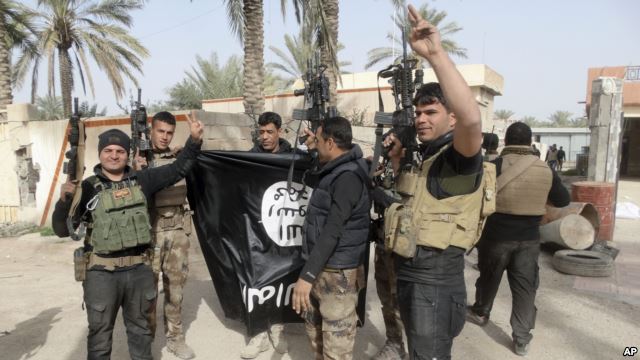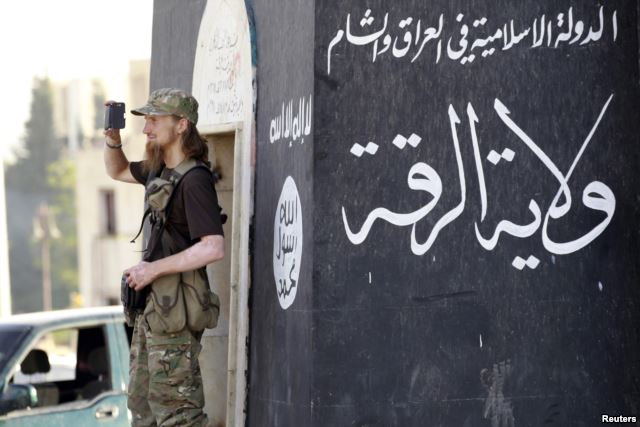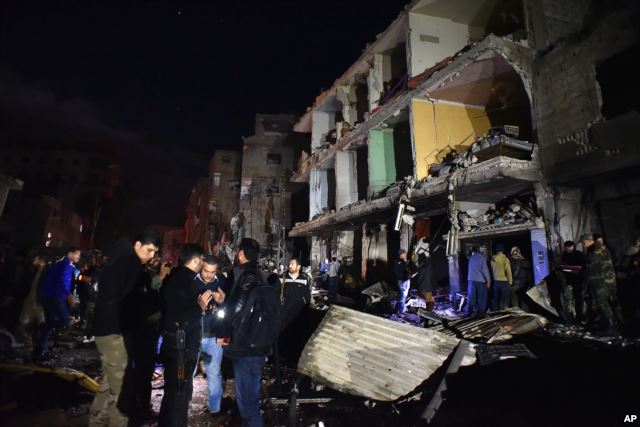IS at Weakest Point Since Start of Bombing Campaign, US Says

Efforts to squeeze the Islamic State (IS) in Iraq and Syria have put the self-declared caliphate on shaky ground, leaving the terror group in perhaps its most vulnerable state since the start of the U.S.-led bombing campaign, according to U.S. officials.
For months, U.S. military officials have been touting IS's territorial losses — up to 40 percent of the land it once controlled in Iraq and upward of 10 percent of the areas it held in Syria.
But military and intelligence officials now say the bombing campaign, along with pressure from U.S. partners on the ground, is eating away at IS's ability to send forces into the fight.
"ISIL is at its weakest point since its rapid expansion in 2014," a U.S. intelligence official told VOA on condition of anonymity, using an acronym for the terror group.
"The flow of foreign terrorist fighters to Syria and Iraq has been reduced," the official said. "Consequently, ISIL is no longer able to replenish its ranks at the rate its fighters are dying on the ground."
Tipping point reached
Just a year ago, senior military officials said IS was bringing in as many as 1,000 foreign fighters a month. "They've been able to continue to recruit at the rate we kill them," one such official told VOA at the time.
"That has drastically dropped off," Maj. Gen. Peter Gersten, deputy commander for operations and intelligence for Operation Inherent Resolve, told Pentagon reporters during a video briefing Tuesday. "Our estimates are down to around 200 [a month]."
The Pentagon this week also reaffirmed U.S. intelligence estimates that the total number of fighters IS can muster in Iraq and Syria is now in the range of 19,000 to 25,000, down from earlier, high-end estimates of up to 32,000.
"We're seeing a fracture in their morale," Gersten said, pointing to increases in IS desertion rates.
'Still in the fight'
Yet despite the growing optimism, there are persistent concerns about underestimating the terror organization's capabilities and staying power.
Contrary to some military assessments, U.S. intelligence officials have said they believe IS is not being forced to turn to child soldiers and is still "largely dependent" on foreign fighters and recruits from areas the group controls.
"There's no doubt that they've taken losses, but there's no doubt they're still in the fight," said Thomas Joscelyn, a senior fellow at the Foundation for Defense of Democracies and senior editor of The Long War Journal.
Joscelyn is one of a number of analysts who has consistently been skeptical of official U.S. estimates for the size of the IS force, pointing to Washington's own estimates of the number of IS fighters killed in airstrikes — about 25,000 — as reason to be wary.
"You're saying they've basically replaced their entire fighting force," he said. "That's hard to believe given that ISIS is still an effective fighting force on so many battlefronts."
Per Joscelyn's own estimates, at its peak, IS possibly had as many as 50,000 fighters in Iraq and Syria. And he said recent claims by the group's Amaq News Agency that it launched 287 suicide or "martyrdom operations" in the first three months of 2016 "implies that they have quite a roster of available martyrs."
Still, others contend that the new U.S. assessments of a much smaller IS force may be on the money.
"There has been a lot of evidence that these fighters are being degraded at an enormous rate," said Malcolm Nance, a former counterterrorism and intelligence officer, including what he described as "fantastic rates of suicide bomber usage for even the most basic combat operations."
Nance, who now heads the Terror Asymmetrics Project, said the newer U.S. estimates may also reflect intelligence, possibly even detailed information on foreign and local fighters, collected during the May 2015 raid that killed top IS financial figure Abu Sayyaf.
Strategic shrinkage
But even if IS's fighting force is shrinking considerably, the terror group's own strategy has likely played a role.
"ISIL's public calls for fighters to wage jihad on other fronts has probably also been a factor," a U.S. intelligence official said.
For months, IS has been telling would-be jihadists not to go to Iraq or Syria, but to go to Libya instead, seen by some analysts as a lynchpin in the terror group's Africa strategy.
"It’s long-stated its goal is to endure and to expand," John Watts, a senior fellow with the Atlantic Council told the House Homeland Security Committee on Wednesday.
"As it is squeezed within its self-proclaimed caliphate, the importance of finding new safe havens and new targets increases," the former Australian Army officer said, warning that the group apparently has yet to settle precisely on how to move forward.
"There is currently a split between various ISIS leadership factions as to whether they should prioritize to retain the current territory at all costs or devolve into a decentralized international terrorist organization," Watts said.
Some former intelligence officials say time may be running out for the terror group's leadership to make that call, as IS's supply of fighters continues to erode.
"I think the appeal of the caliphate is being lost," said the Terror Asymmetrics Project's Nance. "Two hundred [foreign fighters] per month may be high unless coming from Syrian lines or crossing Saudi desert."
Политика конфиденциальности | Правила пользования сайтом










